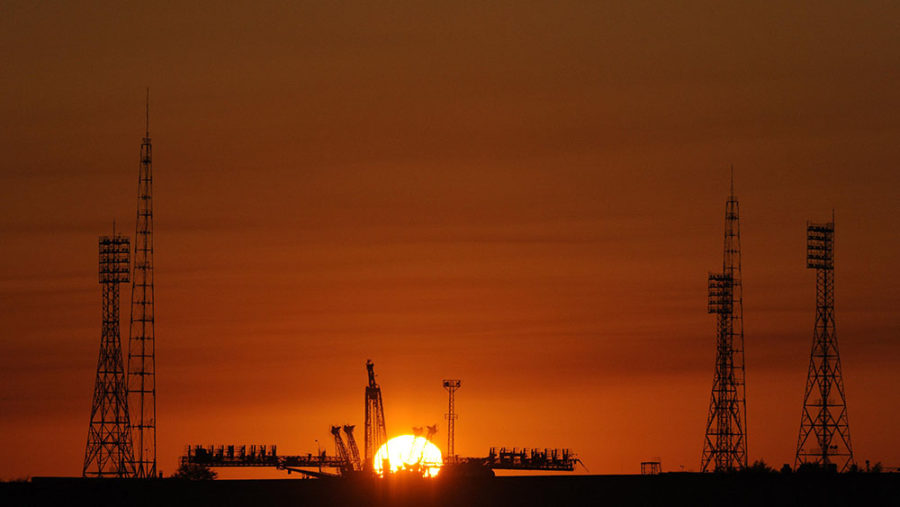Farwell of Gargarin’s Start
62 Years After its First Launch in May of 1957, Baikonur Site-1, Otherwise Known as Gagarin’s Start will be Decommissioned after Soyuz MS-15 in September
Site 1/5 was commissioned to be built in 1954 during the height of the Cold War. The Soviet Union was developing Intercontinental Ballistic Missiles or ICBMs to carry a nuclear warhead, possibly toward the United States, in the event of a nuclear war. Sergei Korolev otherwise known as the Chief Designer was in charge of building the ICBMs for the Soviets.
The government searched for a place to launch and test their newest rocket, the R-7A Semyorka. The Soviets chose the area around Tyuratam, located in the then Kazakh Soviet Socialist Republic (SSR), which is now the independent nation of Kazakhstan. In order to disguise the missile test site from the Americans, the Soviets named the site after the town of Baikonur and built a fake pad there. However, the Tyuratam site became known as Baikonur.
After construction of the site concluded, the first launch of the R-7 occurred on May 15, 1957. However, the launch was a failure. After multiple failed launches, the Soviets were ready to launch Sputnik-1. Sputnik-1 was delivered to orbit and became the first manmade object to do so.
The R-7 was then modified to lift a Vostok spacecraft into space. On April 12, 1961, Cosmonaut Yuri Gagarin climbed the gantry at Site 1/5 and waved to the crowd below. Soon after climbing into the spacecraft, Vostok-1 then lifted off from the Baikonur Cosmodrome at 06:07 UTC. After completing one orbit, Vostok 1 then began its reentry. Prior to landing, Gagarin ejected from the Vostok-1 entry capsule. Gagarin parachuted safely to the ground at 7:45 UTC in the Saratov Oblast region of the Soviet Union. Valentina Tereshkova, the first woman in space launched aboard her Vostok-6 spacecraft from Site 1/5 on June 16, 1963.
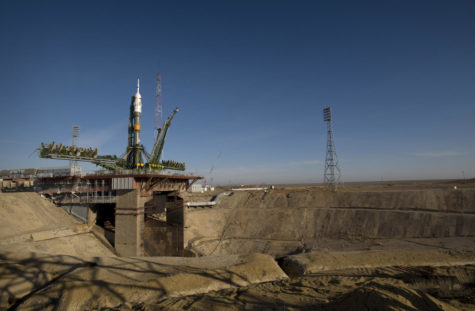
After the completion of the Vostok program, the Voskhod program began. Voskhod-2 in particular was historic when, Alexei Leonov became the first man to walk in space. Documents discovered after the Soviet Union collapsed show that the spacewalk almost resulted in a disaster. Leonov had trouble getting back into Voskhod-2 because his suit became inflated and he could not fit. He nearly had a heatstroke and had to let some air out to get back in. It has been reported that Leonov had a suicide pill in the case he was unable to reenter the capsule, thankfully he never had to use it.
After the Voskhod program, the Soviet Union set its sights on the moon, as they too wanted to be the first to land a cosmonaut on the moon. The OKB-1 Korolev Design Bureau (today’s RKK Energia) designed the Soyuz spacecraft. Soyuz was the Soviet equivalent to the NASA Apollo Command and Service module and was to fly around the moon. Modern variants of the Soyuz spacecraft continue to launch humans to the ISS to this day. Soyuz also uses a variant of the R-7 to launch to space. On April 23, 1967, cosmonaut Vladimir Komarov launched aboard his Soyuz 7K-OK(A) spacecraft from Site 1/5 for the Soyuz 1 mission. Almost immediately issues arose such as only one solar panel deployed instead of two. On the 13th orbit it was decided to abort the mission. After reentry, only the drogue parachute opened and not the main parachute, causing the spacecraft to plummet to the ground, killing Komarov. After impact, the spacecraft burst into flames. After an autopsy, it was determined that Komarov died from blunt force trauma related injuries.
A combination of factors including the Soyuz 1 disaster and the death of the chief designer, Sergei Korolev, left the Soviet space program at a serious disadvantage. The space program continued with a new leader. The Soyuz was fixed and returned to flight and a successful docking between Soyuz 4 and 5 occurred in low earth orbit in 1969. However, the prospects of a Soviet space race victory were rapidly diminishing. The Soviets launched the powerful N-1 rocket a total of four times from 1969 to 1972 from LC-110 at Baikonur. The N-1 was designed as the Soviet response to the American Saturn V moon rocket and would have replaced the R-7 for Soyuz launches. All four massive N-1 rockets were failures, including one that fell back on the LC-110 launch pad. The project was scrapped. The R-7 and therefore Site 1/5 maintained their role in manned spaceflight. The N-1 would become a secret until the fall of the Iron Curtain and the Soviet Union in the 1990s.
After losing the space race, the Soviets shifted their goals from the moon to low earth orbit with space stations. Their first space station was Salyut 1, its design would be the basis for all future Soviet and Russian space station modules. The first mission to the world’s first space station was Soyuz 10, which launched successfully from Site 1/5. But, the crew of Soyuz 10 failed to achieve a hard dock to Salyut 1 on April 24, 1971. After only a soft dock the mission was aborted, and Soyuz reentered the earth’s atmosphere the same day. The next mission was Soyuz 11.
This time, the Soyuz made a successful hard dock on June 7, 1971 to the Salyut 1 station. The crew of Georgy Dobrovolsky, Viktor Patsayev, and Vladislav Volkov conducted experiments for 23 days on Salyut 1. After several mechanical issues and an electrical fire, the crew of Soyuz 11 undocked from Salyut 1. When the Orbital module separated from the reentry module, a valve opened which led to a rapid loss of cabin oxygen. All three cosmonauts did not have pressure suits in order to fit all three in the capsule. The Soyuz successfully reentered and parachuted to the ground. However, when Soviet ground forces opened the hatch they saw all three cosmonauts unconscious. After CPR, Dobrovolsky, Patsayev, and Volkov were pronounced dead. The cosmonauts most likely all died within seconds of cabin depressurization.
Although Salyut two was a failure, Salyut three, four, and five were relative successes. Salyut six was a very big success with six manned Soyuz flights between 1977 and 1981. On Salyut six, the Soviets broke the manned spaceflight endurance record held by the American space station, Skylab. Site 1/5 also launched the first Asian and Hispanic man into space to the Salyut six space station with the Intercosmos program. Salyut seven was the next Salyut station and continued where Salyut six left off.
On Sept 26, 1983, Vladimir Titov and Gennady Strekalov waited in their Soyuz T-10a capsule. With 90 seconds left in the countdown at Site 1/5, a valve failure caused a rupture of RP-1 rocket fuel and a fire on the Soyuz-U rocket. The fire quickly engulfed the rocket, burning through the wires which control the activation for the Launch Escape System (LES). In order to override the LES, two launch controllers, in two separate rooms, in a building 20 miles away had to manually send a signal at the same time to allow the LES to fire. Seconds later, the LES fired, pulling the capsule away from the failing rocket. Six seconds later, the Soyuz-U rocket exploded, severely damaging Site 1/5. Around five minutes later, the two cosmonauts landed a little more than two miles away from the launch pad. The crew were a little bruised due to the high G forces but were not hurt. Site 1/5 burned for around 20 hours and was eventually repaired.
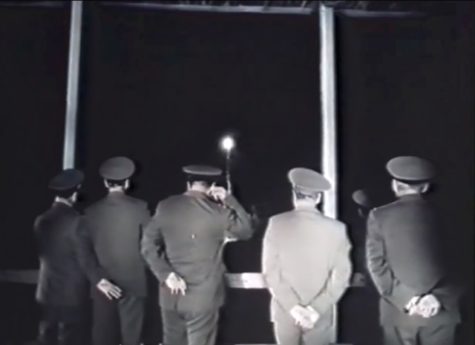
For a period, mission control in Moscow lost contact with Salyut Seven when it was unoccupied. The Soviets decided to salvage the lost station. The crew of Soyuz T-13 with Vladimir Aleksandrovich and Viktor Petrovich were assigned to the unprecedented mission. The crew made a successful dock with Salyut Seven. They then repaired the failed electrical system and got the station back up and running. Feb 1991
On Feb 20, 1986, the successor to Salyut Seven, called Mir (Мир) launched to space on a Proton rocket from Site 200 at Baikonur. The Mir core module was placed in a good orbit waiting for the first crew. Soyuz T-15 launched from Site 1/5 and then rendezvoused and docked with the Mir core module on March 15, 1986. After a short stay at Mir, the T-15 crew undocked and traveled to the Salyut seven station. On Salyut seven they conducted a spacewalk and transferred valuable hardware into Soyuz T-15. They then left Salyut seven and visited Mir once again. Soyuz T-15 remains the one and only space mission in history where a crew visited two space stations.
Over the next couple Mir expeditions, Mir grew from just the core module to multiple modules with the addition of Kvant-1, Kristall, and Kvant-2. Soyuz TM-13 launched from Site 1/5 on Oct 7, 1991 carrying cosmonauts Alexander Volkov, Toktar Aubakirov, and Franz Viehböck of Austria. Soyuz TM-13 arrived at Mir and the crew met with the TM-12 crew whom were on station. After a short time in space, Aubakirov, and Viehböck returned to earth with Anatoly Artsebarsky on Soyuz TM-12 on Oct 10, 1991. Volkov and Sergei Krikalev remained on Mir for the Mir Expedition-10 mission or EO-10.
While the EO-10 crew were orbiting Earth on Mir, the Soviet Union collapsed. Soviet President Mikhail Gorbachev handed over the missile codes to Russian President Boris Yeltsin. The Soviet Union officially fell on Dec 26, 1991, the Russian Federation had begun. However, the Baikonur Cosmodrome was now in a foreign nation, the Republic of Kazakhstan, meaning that the Russians needed to pay rent for the Baikonur Cosmodrome, and it became a military base.
The first post-Soviet launch from Baikonur was TM-14 which launched from Site 1/5 on March 17, 1992. The crew consisted of German astronaut Klaus-Dietrich Flade. After a short period on Mir, Volkov, Krikalev, and Flade returned to Earth on TM-13 on March 25, 1992. Soyuz TM-13 is the only mission to have launched in one country and landed in another.
The Mir space station became the scene of international cooperation in space during the four-year Shuttle-Mir program. The program consisted of shuttle flights to Mir and with some Russians flying on Shuttles while some Americans would fly on the Soyuz. Astronauts such as Michael Foale, Shannon Lucid, and Jerry Linenger flew on Mir for long-term stays between Shuttle flights. Shuttle-Mir was considered “phase one” of the joint program where both nations learned how to work together and carry out long-term stays in space. After a collision with a Progress supply ship (the cargo version of Soyuz) in 1997, and several small fires aboard the aging Mir space station, NASA decided to end the program and focus on the International Space Station program.
The first Module of the International Space Station (ISS), Zarya was launched on a Proton rocket from site 81 on Nov 20, 1998. On Dec 7, 1998, Space Shuttle Endeavour on STS-88 docked to Zarya with the first American component, Unity.
The final mission to Mir launched from Site 1/5 on April 4, 2000. Soyuz TM-30 was funded by the private company called MirCorp. The crew of TM-30 would also make up the Mir EO-28 crew. The mission was an effort by MirCorp to reactivate the station and potentially commercialize space. The Russian space agency, Roscosmos stopped funding Mir to focus on the infant ISS. It was decided that due to the lack of funds and the aging of the 14-year-old station that the deorbit of Mir would occur. Mir reentered the Earth’s atmosphere over the South Pacific Ocean on March 23, 2001.
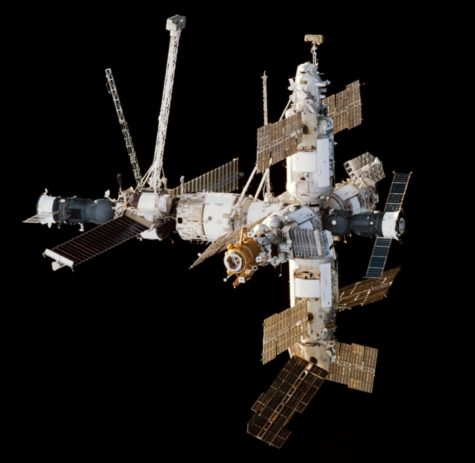
The first Expedition to the ISS, Expedition-1, launched on Soyuz TM-31 from Site 1/5 on Nov 2, 2001. The crew of Expedition-1 consisted of William M. Shepherd, Yuri P. Gidzenko, and Sergei K. Krikalev. At the time, only the Unity, Zarya, and Zvezda modules were present. The crew of Expedition-1 landed on board Space Shuttle Discovery on STS-102. As the ISS continued to grow, a combination of Shuttle and Soyuz flights launched crew to the station. Large station modules, solar arrays, and truss segments were launched to the station in the payload bay of the Space Shuttle.
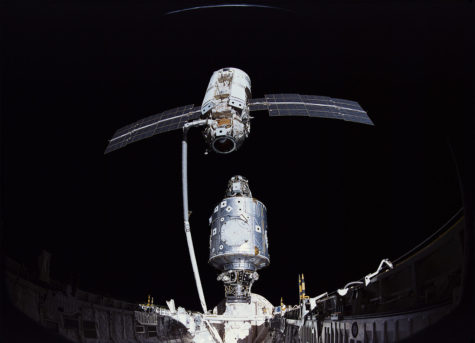
On Jan 16, 2003, Space Shuttle Columbia launched on STS-107 carrying Rick Husband (commander), Willie McCool (pilot), Michael Anderson (Payload Commander), Kalpana Chawla (Mission Specialist), David Brown (Mission Specialist), Laurel Clark (Mission Specialist), and the first Israeli in space, Ilan Ramon (Payload Specialist). Once in orbit, the mission was spent conducting scientific experiments in the SPACEHAB Research Double Module located in Columbia’s payload bay. However, a block of foam from the External Tank broke off and caused a hole in the left wing’s Reinforced Carbon Carbon section. The Shuttle broke up over Texas and Louisiana on Feb 1, 2003 during reentry, killing all aboard. Due to the disaster, NASA relied on the Soyuz for crewed launches for three years until the Shuttle Program recovered.

After a long investigation into the Columbia disaster, the Space Shuttle returned to flight with the launch of Shuttle Discovery on STS-114 on July 26, 2005. The Shuttle then became dedicated to the construction of the ISS. The ISS completed construction in 2011 and is now the largest Space Station ever built. After Shuttle Atlantis landed in 2011 after STS-135, NASA began a reliance on the Soyuz once more.
On March 27, 2015, Gennady Padalka, Mikhail Korniyenko, and Scott Kelly launched on Soyuz TMA-16M from Site 1/5. Kelly and Korniyenko spent a year on the ISS and conducted scientific experiments on board. Scott Kelly and his twin brother, Mark Kelly, both twins and astronauts participated in a study to measure the effects of zero gravity on the human body.
On Oct 11, 2018, cosmonaut Aleksey Ovchinin and astronaut Nick Hague launched on board their Soyuz MS-10 spacecraft from Site 1/5. During the launch, a manufacturing defect on one of the side boosters on the Soyuz-FG rocket caused the booster to impact the second stage. The abort motors on the launch shroud pulled the Soyuz capsule to safety. Ovchinin and Hague landed near the town of Jezkazgan, Kazakhstan after a ballistic decent. This was the first launch abort since Soyuz T-10a in 1983. Ovchinin and Hague would later go on to launch on Soyuz MS-13 with Christina Koch on March 14, 2019. The crew is currently on the ISS for Expedition 59/60 along with the Soyuz MS-12 crew.
Currently, the Russian space agency, Roscosmos is phasing out the Soyuz-FG variant of the R-7 rocket and replacing it with the Soyuz-2 variant, which has a modernized digital guidance system and a new third stage engine. According to ArsTechnica, the “Soyuz 2.1b [a type of Soyuz 2] has a payload capacity of 8.2 tons to low-Earth orbit, in comparison to 6.9 tons with the Soyuz FG booster.”
Due to a lack of funding for Roscosmos, all flights after Soyuz MS-15 in September will launch from the upgraded Site-31 launch site and Gagarin’s Start (Site 1/5) will be retired. Site-31 was built during the Cold War for additional R-7 ICBM launches, the first being on Jan 14, 1961. Site-31 has been used for manned launches when Site 1/5 was unable to support launches. Manned missions like Soyuz TMA-06M, Soyuz TMA-15M, and Soyuz MS-02 have launched from Site-31. Soyuz MS-15 will consist of the first UAE (United Arab Emirates) astronaut in space. The decommissioning of Gagarin’s Start will mark an end of an era for manned Russian spaceflight.


